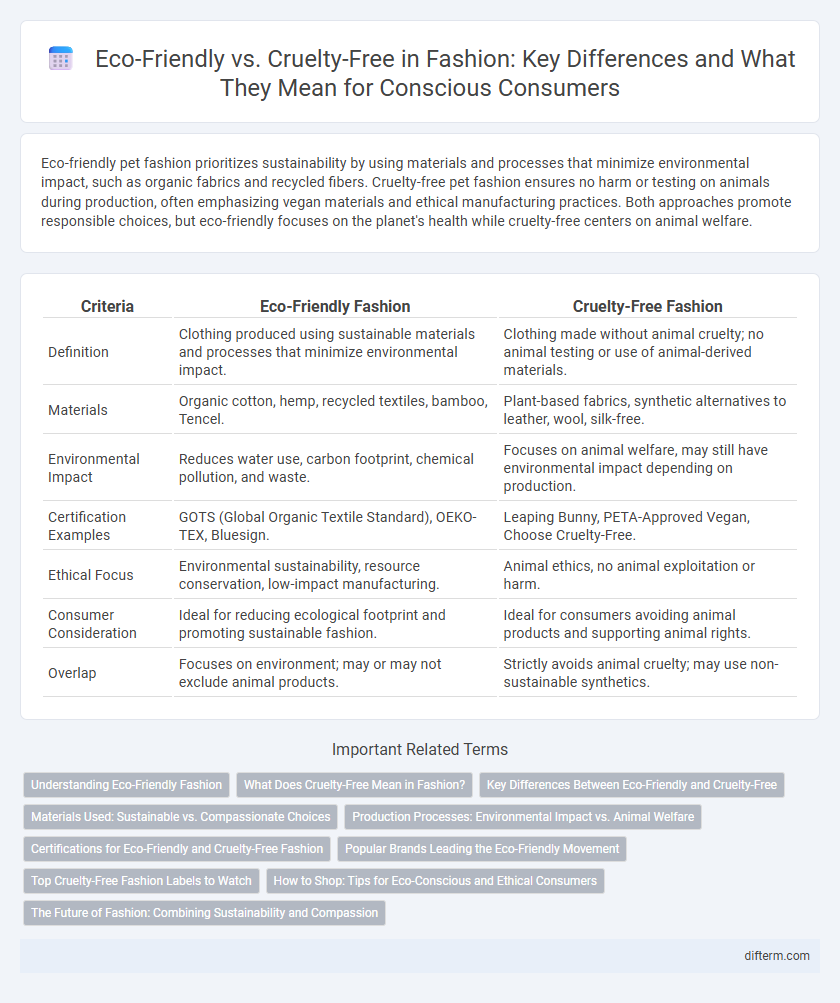Eco-friendly pet fashion prioritizes sustainability by using materials and processes that minimize environmental impact, such as organic fabrics and recycled fibers. Cruelty-free pet fashion ensures no harm or testing on animals during production, often emphasizing vegan materials and ethical manufacturing practices. Both approaches promote responsible choices, but eco-friendly focuses on the planet's health while cruelty-free centers on animal welfare.
Table of Comparison
| Criteria | Eco-Friendly Fashion | Cruelty-Free Fashion |
|---|---|---|
| Definition | Clothing produced using sustainable materials and processes that minimize environmental impact. | Clothing made without animal cruelty; no animal testing or use of animal-derived materials. |
| Materials | Organic cotton, hemp, recycled textiles, bamboo, Tencel. | Plant-based fabrics, synthetic alternatives to leather, wool, silk-free. |
| Environmental Impact | Reduces water use, carbon footprint, chemical pollution, and waste. | Focuses on animal welfare, may still have environmental impact depending on production. |
| Certification Examples | GOTS (Global Organic Textile Standard), OEKO-TEX, Bluesign. | Leaping Bunny, PETA-Approved Vegan, Choose Cruelty-Free. |
| Ethical Focus | Environmental sustainability, resource conservation, low-impact manufacturing. | Animal ethics, no animal exploitation or harm. |
| Consumer Consideration | Ideal for reducing ecological footprint and promoting sustainable fashion. | Ideal for consumers avoiding animal products and supporting animal rights. |
| Overlap | Focuses on environment; may or may not exclude animal products. | Strictly avoids animal cruelty; may use non-sustainable synthetics. |
Understanding Eco-Friendly Fashion
Eco-friendly fashion emphasizes the use of sustainable materials like organic cotton, recycled fabrics, and low-impact dyes to minimize environmental harm during production. This approach prioritizes reduced carbon footprints, water conservation, and biodegradability to ensure long-term ecological balance. Understanding eco-friendly fashion involves recognizing the importance of resource efficiency and promoting circular economy practices within the apparel industry.
What Does Cruelty-Free Mean in Fashion?
Cruelty-free in fashion means that no animals were harmed or subjected to testing throughout the production process, ensuring ethical treatment of all living beings involved. This concept typically excludes the use of animal-derived materials like fur, leather, and wool, favoring alternatives such as synthetic or plant-based fabrics. Brands emphasizing cruelty-free practices often obtain certifications from organizations like PETA or Leaping Bunny to validate their commitment to animal welfare.
Key Differences Between Eco-Friendly and Cruelty-Free
Eco-friendly fashion emphasizes sustainable materials, reducing environmental impact through resource conservation and waste minimization, while cruelty-free fashion focuses on avoiding animal testing and the use of animal-derived products. Eco-friendly brands prioritize carbon footprint reduction and biodegradable fabrics, whereas cruelty-free labels ensure products are not tested on animals and exclude animal by-products like leather or fur. Understanding these distinctions helps consumers align their purchases with values such as environmental sustainability or animal welfare.
Materials Used: Sustainable vs. Compassionate Choices
Eco-friendly fashion emphasizes materials sourced from sustainable resources like organic cotton, hemp, and recycled fabrics to minimize environmental impact. Cruelty-free fashion prioritizes materials that avoid animal testing and animal-derived products, such as plant-based leathers and synthetic alternatives. Choosing between these approaches involves balancing ecological preservation with ethical treatment of animals in material selection.
Production Processes: Environmental Impact vs. Animal Welfare
Eco-friendly fashion prioritizes sustainable production processes that minimize environmental impact by using organic materials, reducing water consumption, and cutting carbon emissions. Cruelty-free fashion focuses on animal welfare, ensuring no animals are harmed or exploited during manufacturing, often avoiding leather, wool, and silk. Brands integrating both practices promote transparency and accountability while reducing ecological footprints and protecting animal rights.
Certifications for Eco-Friendly and Cruelty-Free Fashion
Certifications such as GOTS (Global Organic Textile Standard) and OEKO-TEX validate eco-friendly fashion by ensuring sustainable materials and environmentally responsible production processes. Cruelty-free fashion is often certified by organizations like PETA or Leaping Bunny, which guarantee that no animal testing or animal-derived materials were used in the product development. These certifications provide transparency and trust for consumers seeking ethically and environmentally conscious fashion choices.
Popular Brands Leading the Eco-Friendly Movement
Popular brands leading the eco-friendly movement in fashion include Patagonia, Stella McCartney, and Reformation, known for their sustainable sourcing and environmentally conscious production processes. These brands prioritize using organic materials, recycled fabrics, and reducing carbon emissions to minimize environmental impact. Their commitment to eco-friendly practices sets a benchmark in the industry, contrasting with cruelty-free brands that primarily focus on animal welfare without necessarily addressing broader environmental issues.
Top Cruelty-Free Fashion Labels to Watch
Top cruelty-free fashion labels to watch include Stella McCartney, known for pioneering sustainable luxury without animal testing. Brands like Matt & Nat emphasize vegan materials, combining style with ethical commitments. Ethical fashion consumers increasingly favor these labels for their transparency and cruelty-free certifications.
How to Shop: Tips for Eco-Conscious and Ethical Consumers
When shopping for fashion, prioritize brands that use sustainable materials such as organic cotton, recycled polyester, and Tencel to minimize environmental impact. Look for certifications like GOTS (Global Organic Textile Standard) for eco-friendly products and Leaping Bunny or PETA-approved logos to ensure cruelty-free production. Support companies with transparent supply chains and ethical labor practices to align your purchases with both environmental and animal welfare values.
The Future of Fashion: Combining Sustainability and Compassion
Eco-friendly fashion prioritizes materials and production methods that reduce environmental impact, such as organic cotton, recycled fabrics, and low-water dyeing techniques. Cruelty-free fashion emphasizes the ethical treatment of animals by avoiding animal-derived materials like leather, fur, and wool, instead using alternatives like plant-based or synthetic fibers. The future of fashion lies in integrating both sustainability and compassion, creating innovative designs that respect the planet and all living beings while meeting consumer demand for responsible products.
eco-friendly vs cruelty-free Infographic

 difterm.com
difterm.com